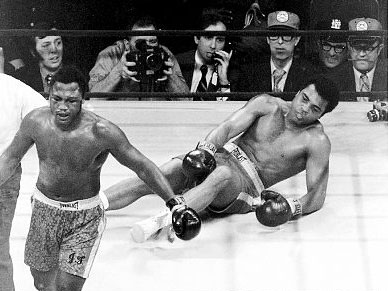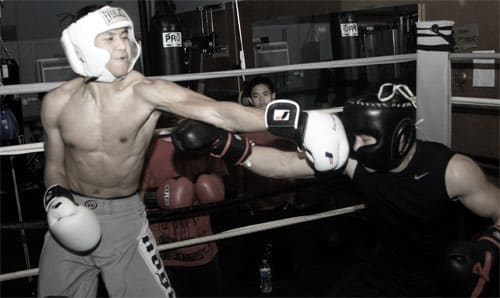
A quick rundown of the 6 boxing defense techniques. Footwork, blocking, parrying, rolling, slipping, and countering! Learn how each defensive technique is used, their advantages and disadvantages. I list some examples of how they might be effective or ineffective in fighting situations.
1a. Footwork (GOING AWAY)
Quite possibly the best defensive technique ever invented. (Haven’t you ever heard the best self-defense technique is to run?) Why bother learning how to slip or roll under punches when you can run away? The problem is that you can’t attack when you’re running away. Or at least if you want to counter, you have to spend tremendous amounts of energy to bring yourself back into range again to fire counters. So basically running is easy to do and very effective but there’s little option to counter. This is probably why so many guys start running when they know they’re up on the scorecards.
PROS:
- moving away is the easiest way to avoid getting hit (complete evasion)
- avoids anything and everything
- great way to frustrate opponent, tiring him out by making him hit air
- works well against slower, heavy-footed opponents
CONS:
- moving the body takes a lot of energy
- hard to counter (or slow to counter)
- moving the body can be slow
- you can lose fight decisions for not showing aggression
1b. Footwork (GOING AROUND)
Pivots, side-steps, lateral movement. Great for moving away from a punch while still keeping yourself in range to counter. Good stuff, very effective in theory but not efficient and definitely not sustainable over the long run. Sure you can pivot around a punch or two here and there but it takes too much energy to move your entire body when your opponent is only moving his arm. You end up committing more energy which only pays off if you land deadly counters. Nonetheless, moving around your opponent is a great way to use angles and to simultaneously attack and defend. When you work hard to get into range, good technique will help you stay in range without getting hit.
PROS:
- moving around creates great angles
- sometimes only way to escape bad positions (like against the ropes)
- works well against slower, heavier-footed opponents
CONS:
- risky if you get caught while moving (requires skill to evade at close range)
- hard to punch while moving
- still uses some energy
1c. Footwork (GOING FORWARD)
Smothering is a classic way to avoid punches. Instead of stepping away and being too far, now you step forward and get too close. If you’re able to get close, see if you can get on top of your opponent. Try to project your chest onto your opponent’s head and crush him to keep him from exploding back at you with punches. There’s no easier way to take away your opponent’s weapon by grabbing his arm.
PROS:
- great for neutralizing opponents’ punches
- clinch/tire out small guys
- keeps you in range of tall guys
- push opponents around (push them off balance or move them around)
- tire out weak-legged guys by making them move
CONS:
- can get out-clinched or outworked on the inside if opponent is better inside fighter
- can be tiring against well-grounded opponents
- fighters using dirty tactics (head butts, low blows)
- might walk into punches
2. Blocking
This is your basic boxing defense. Blocking is the easy way to defend without taking yourself out of range. Requires little energy and little skill. If you really think about it, blocking is not your first defensive skill-it’s your first COUNTER-OFFENSIVE skill. Simply cover your vulnerable areas, don’t try to “catch” the punch, fire back after you block.
Blocking covers both head and body and doesn’t leave you open to follow up punches. There are several drawbacks, mainly that it’s slow to counter (because hands are busy blocking) and also that you still absorb partial damage. Blocking is not very helpful for closing distance against longer armed opponents that can push you back, or defending against bigger opponents who can still hurt you through your guard, or faster opponents who retract their arms before you counter. Blocking too much can leave you stuck in your defensive shell and lose decisions for not showing aggression.
PROS:
- effective against all punches
- easy (doesn’t require much skill, energy, reflexes)
- completely closed up
- great for all but the heaviest punches
- safe way to fight for fast punchers (block & counter)
- safe way to fight at close range
- easiest way to defend body punches
- good defense for jabs (most common boxing attack)
CONS:
- requires high energy/high speed to counter (slow to counter…arms used as defense)
- can be trapped in a shell
- take partial damage (not effective against bigger or more powerful opponents)
- not recommended against opponents that use long arms or volume to keep pushing you back
- hard to counter against faster opponents that retract their arms fast
- hands sometimes block vision
3. Parrying
It’s like a block but you’re slightly deflecting your opponent’s punch away with your hand. A small carry can take the power of your opponent’s hardest punches, whereas a big parry can guide your opponent off balance and vulnerable using his own momentum. At some point all your blocks should be made with a slight parrying motion to blunt the hardest punches.
The parry is a great way to wear out your opponents by using their momentum against them. It works best against guys that take more energy to commit to their punches, especially power punchers and long-armed punchers. The power punchers are always committing tremendous body force which is an opportunity to parry their punch and create openings for your counters. Long-armed punchers are especially vulnerable to parry since they have take longer to retract their punches. By making them miss and parrying their punches you will tire out their long arms faster.
The drawbacks to the parry is that it doesn’t work well against light punchers (that use no momentum) and also against curved punches. There is also a risk of leaving yourself vulnerable to fakes if you’re trying to parry a punch.
PROS:
- great for power punches
- great for straight punches
- great for long punches
- great for push punches (body weight committed)
- create vulnerability for counters, make them off balance or slow down arm recovery
- tiring opponents, especially long-armed opponents and power-punchers
- useful for long-armed fighters that can hold their hands out while their head is out of reach
- useful for shorter fighters to deflect punches as they get inside
CONS:
- ineffective against fast/light/non-committed punches
- doesn’t work against curved punches
- not always effective against combination punchers
- can leave you open if you get faked
- hard to do at close range
- still a tiny bit slow for countering the fastest punchers because hands are still used for defense
- not particularly helpful against body punches
4. Rolling
The shoulder roll is naturally the next step up from the parry technique. Instead of deflecting punches with your hands, you use your body now. The shoulder roll is incredibly effective because your body can roll off your opponent’s best shots with ease while keeping your hands free to counter faster. The shoulder roll relies on rhythm for defense and effectively neutralizes entire combinations at even close range.
The drawback to the shoulder roll is that it is ineffective against smaller, faster shots like the jab–which are thrown the majority of the time. The shoulder roll can also leave you highly vulnerable to a punch if you get faked and/or roll in the wrong direction.
PROS:
- effective and easy against multiple punches
- great for power punches
- frees up the hands for faster counter punching
- covers both head and body easily
- can work when blind or off-balanced
- will deflect power even when punches land
- save shoulder energy & gives tricky counter angles (when done with front arm down)
CONS:
- ineffective/unnecessary against weak punches (like jabs)
- less effective in cross-stance match-ups (southpaw vs orthodox)
5. Slipping
Slipping is the most skillful defensive boxing technique. It requires complete evasion of the punch by displacing the head or body to one side, USUALLY by going to the outside of the oncoming punch. It is incredibly effective in that the opponent misses entirely and your hands (and body) are completely free to counter or escape.
The drawbacks to slipping is that it requires very high skill and awareness to pull off successfully. It’s not enough to avoid the punch, you have to be in position to counter immediately since it isn’t realistic (energy-wise) to slip entire combinations. Should you make any mistake during slipping, you will take a direct hit.
Slipping is the best way (sometimes the only way) to counter against really fast opponents. Sometimes it’s the only way to close distance against a taller opponent, or escape off the ropes. The drawbacks to slipping is that it’s very hard to use against body punches and fast volume punchers that throw many sharp fast punches. Slipping can also be very tiring mentally and physically to do throughout and entire fight and leaves you especially vulnerable if you’re faked out.
PROS:
- hands and body completely free to counter instantaneously
- creates huge vulnerabilities in opponent (he is wide open during missed punch)
- avoid punch entirely, no contact (assuming successful slip)
- create escapes (great way to escape when trapped in the corner)
- allows you to come forward while defending
- can be done with arms down (preserving shoulder muscles)
- complete evasion easily breaks your opponent’s punching rhythm (combo-breaker)
CONS:
- requires great skill
- highly vulnerable if caught
- highly vulnerable if faked
- not recommended against multiple punches (very hard and/or tiring)
- not really possible against body punches
6. Countering
Yes, offense (or counter-offense) is the best defense. See if you can evade your opponent’s punch by landing one of your own. Maybe your punch cuts straight up the middle intercepting his, or maybe your punch pulls your head out of the way of his punch. If you really think about it, all defense techniques are simply a way of getting you in position to counter–but if you can counter right off the bat, that’s even better.
PROS:
- maintains effective aggression, being offensive or counter-offensive
- no better defense than hurting your opponent badly as he tries to punch
- best way to go from defensive to offensive
- effective way to stop volume punchers
- more energy efficient since you’re combining offense and defense in one motion
- best time to hurt your opponent, counters cause the most damage
CONS:
- can be tiring since opponents are forcing you to fight at their pace
- potentially deadly when exchanging punches
- your counter might get countered
What’s the BEST DEFENSIVE TECHNIQUE?!
The best defensive technique? No such thing. Use the one that fits your situation. Use the one that feels the most natural in that moment. If you have to think about it, it’s probably not natural. Evade your opponent’s punches any way that you can and be sure to counter right away. Different techniques will work best against different opponent styles. Great boxers are forever adapting their offense to get around your defense, so you’ll have to keep changing up your defense to keep them off you.
There are unlimited ways to beat an opponent. If you were a short guy fighting a tall fighter, you might want to parry from long distance to tire out his arms, then slip to get inside, and then move sideways to avoid his punches while staying in range. Or you might try to walk him down by coming in with a high guard and shoving him off balance repeatedly. Be creative and always know that you have many different boxing techniques at your disposal! Styles make fights!
Defensive technique is for avoiding punches
WHILE STAYING IN RANGE TO ATTACK!
The point of defense is to be more effectively offensive. If you don’t punch back, there is no point to even staying in range of your opponent. Learning how to use all these defensive techniques will help you block, deflect, and evade even the most skillful punchers! But most important of all, defensive techniques should make you more offensive!
What defensive techniques are you using now?
Which ones work best together?
Which ones might be helpful to your game?











When someone throws a punch on my shoulder are they getting points? where are the points dictated? elbow up or what? i have always been curious sir.
For amateur boxing, points are scored for clean hits to the head using the white part of the gloves. For pro boxing, points are scored for being effectively aggressive (within the rules of boxing). For general boxing skills, I suggest you learn how to attack both. Even if you’re competing in the amateurs, you need to hit the body to make him drop his arms. Always going for the head makes it all too easy to defend.
Amateur boxing also rewards punches to scoring areas of the body,however they usually aren’t counted as easily as head shots.
Are you sure about this? Can Johnny and you give me a clear concept of scoring points by hitting in the body range?
I have an amateur bout in a few days and my opponent has a strong guard. He doesn’t let it move from infront of his face and does not mind getting hit by punches in his body at all. My plan was to give him a lot of body shots and earn points that way, but your comment makes me feel like I need to change my plan.
Thanks.
Take what he gives you. If you hit him right, he’ll cover his body, that’s for sure.
Hi Johnny!
Discovered your page a while a go and was kept busy reading!
As you are an experienced Boxer- I wanted to ask you an unusual Question.
Since ist not your objection to clinch in a Boxing match, (atleast not Focus) i wondered if you still figuered a tactic for you over the years HOW to clinch?
Like “im getting cornered , now its time for Shooting the clinch”? or are you just running in with your guard high?
asking this as a grappler
Thanks in Advance!
Hi Frederik, I’ve gone over clinching tactics in my Boxer’s Guide to Inside-Fighting
Best article on defense in universe (including middle-earth:) Very good compilation of the things talked in the site with addings, very mind clearing. It shows the very important point on boxing; defense and offense are at their best when they used effectively together. Our trainer in the gym says “one punch – one defense” which i guess a simple and very good explanation of this. Thanks bro.
“Best defense article in the universe including middle-earth” — lol.
I have a problem where i find i can block quite well but as soon as i go on the offence with a jab my opponent throws his jab and both of us end up getting hit! its so frustrating because i cant follow up with the rest of my combo because his jab connected and we both end up lookin clumbsy wich in the end makes both of us not throw any punches cos we both know what will happen aaaaaaaarrrrrh!!sorry! Plz help me.
Hey, You coulds just Wait for him to jab? Make your opponent hit you first. Block his hit. Then follow through with a hook or cross. Give it a try!
Hey Danny. If both of you are scared to be aggressive, turn down the pace and throw lighter shots so that both of you are able to fight fluidly through getting hit. In sparring, I sometimes just walk into the same shot over and over, but each time being more aware of how he’s throwing it and where it’s coming from. Little by little I start to see his vulnerability and tell-tale signs and within the multiple hits, I learn the perfect counter for it. This is all possible only through slower, lighter sparring. Give it a try. If you’re hitting so hard that you don’t want to fight, you’re going too hard.
One way to jab and avoid his jab is to lean abit to the right while jabbing, that way you can slip his jab while u jab him. This is for orthordox vs orthordox. Leaning right whole jabbing also gives slightly more power to ur jab. Try it 🙂
Hey Dave, this is a common problem for beginning boxers. There are a few solutions to this. First your practice as Johnny said. It will help a great deal. Second, use a different angle. Just move slightly off to your outside at a 30 degree angle. It will take you off the line and it will give you a better angle on the jab as well. Obviously timing will be your best ally but that is achieved through training as Johnny said. The next thing that you can try is to catch his jab with your right glove as you throw your own. The last thing that you can add to your toolbox is to move your head as you jab. Just slip to the right slightly as you jab. It will keep your head off line.
Train hard, fight easy!
Ill try anything thnx dude
Thanx jonny sound adivce ill try to slow it down in future thanx again boss?:-)
hey danny, sounds like you should be parrying or blocking the jab as u punch man. its pretty simple really.
if you want to block keep your fist up, jab, bring your right hand infront of your chin to catch his jab. all you gotta do is keep your right hand open and up and in front of your chin so youre seeing all of the back of the glove. as youre throwing the jab, put your right hand so you can catch his jab like a mitt. it kinda looks like your right hand is a cobra snapping at the opponents fist. your fist shouldnt move more than 3 or 4 inches, but it should be a hard shove. get a partner and practice outside the ring.
if ur opponent is getting his jab onto you first, you may have to parry him instead. to parry a jab, keep your right hand guard high, push your opponent’s punch downwards with a tiny hand shove. there are parrying videos on the site, down parrying is a very good way to mess up your opponents jab.
you could jab as you slip the jab to the inside as well. thats not so easy to do if ur still new tho
and at some point hes going to figure out what youre doing and try to counter your jab. if you want to figure that out, feint a jab instead of throwing it. see how he reacts.
to practice feinting, just practice your normal jab on a bag, and with each punch slow down your movement. dont change the motion, just go through it slow motion. when you feel like you can do the jab motion exactly but in slow motion, just do the jab until it’s say 3 or 4 inches from your guard position. 10% of your jab-then speed it up. its gotta look like the first part of the real jab tho not just the fist going out. it needs to have 10% of the your normal jab’s torso turn, the leg movement. then speed up until your 10% of the jab is as fast as a jab.
when going against ur opponent feint, see if he falls for it and throws his jab. you will know he’s waiting for your jab. he may stop trying to time your jab, or he may not realise. now you could time him, because your feint will make him jab, and you can nail him with a counter overhand right. and all these techs are on the site so look at the vids these text descriptions make little sense to me if i was reading em 🙂
All the way from Africa,Kenya
Jonny your my favourite boxing teacher
good work
This is by far my favorite article ever. Keep em comin Johnny!
More “favorites” to come, Mac!
@ saber I can visualize what u textd it helps and it makes a whole lot of sense ty!
Whats the motive to manny paquiao’s triangle guard?
A, that’s his way of blocking bigger punches by using his forearms and upper-arms instead of just his hands.
So basically its his own style then.
Exactly. If you have a different body type or different mindset, you might or would fight differently.
Hey Johnny,
Big fan here. First off, great work with developing the site, the format, the articles, and videos. This site has come a long way. Secondly, we fans really appreciate you interacting with us. It’s not easy, but you manage to pull it off pretty well, so thank you.
Lastly, I would recommend just one thing. It would be great if we could subscribe/RSS your articles to Google Reader – that way we could get your stories automatically. Just a thought. Keep up the good work! Looking forward to your exercise /body articles.
-max
Great idea, Max. A while back when I was developing the new site I figured RSS was dead but I guess not. I’m going to see if I can enable the RSS module. Thanks for letting me know!
Hey max, can you please try this URL and see if it works with your RSS reader? https://expertboxing.com/feed/rss
Jhonny N, hello, you could write something about the mitt works, the style of Roger Mayweather
Yes, I could Herik. I learned the Mayweather mittwork style a while back but it will take some time to explain with a video. It’s on my list, though. Very easy method for the puncher, but a little bit of work for the trainer.
johnny is there any other way to beat a taller fighter other then just being a puncher using bob and weave ie joe frazier miketyson style???
Oh yeah, Jack. It’s possible to beat taller fighters even without slipping at all. Sometimes I like to walk down tall guys with a high guard and let them punch themselves out. Instead of slipping, I’ll jerk my head back so their arms swing at air and get tired faster.
Other times, I throw lots of body jabs to push the taller fighter off balance, then I rush him for the kill. Sometimes, I’ll stand right in front of him and trade right hands with him. I’ll block all his jabs but the moment I see his right hand, I trade mine with his. (I do this intelligently, of course. Slipping my head slightly outside his as mine lands.)
thnx buddy
another question i would like to ask is that does lifting weights effect my boxing??
i life weights in small rep i.e 1-3
I was powerlifting when I first started boxing. All trainers and fighters told me to stop and they were right. I stopped lifting weights and my whole body became faster, more powerful, and more endurance. The difference was like night and day. If you’re serious about your boxing performance, you’ll stop lifting heavy weights.
they r heavy
I have pretty long arms (73″ , I’m 5’8″). What do you think is the best defensive technique to utilize my length without spending tremendous amounts of energy ?
All defensive boxing techniques will help you defend without using tremendous amounts of energy. Blocking, parrying, rolling, and slipping. Neither of these rely on long arms. Perhaps the only defensive technique that relies on long arms is pushing, but that still somewhat uses energy.
Ahhh! I know…the JAB. Probably the best defensive technique right there AND it makes great use of your long arms.
That’s got to be it . I would definitely say that I’m still in the infancy of my boxing training, so jabs are right up my alley .
First of all I like to thank you to spent your time and write this articals, I like how you made pros and cons,
Absolutely awesome summary article. Very important to note the pros and cons of each defensive technique and understand how and when to use them. I will be re-reading this down the line for sure because the better you understand your defensive options, the more flexibilty you have to adapt to any opponents style and attributes.
Hey Johnny, what are the best techniques of defense for street fighting? Or are all effective in the fight in the street?
Street fighting is totally different. Blocking and parrying becomes less effective but rolling, slipping, and footwork are much more effective.
johnny, you could post an article that relates about rope-a-dope, the strategy I use ali vs foreman?
Krat,
I can explain the rope-a-dope strategy in 2 sentences:
1) Lay on the ropes and look passive.
2) Explode off the ropes with devastating counters while opponent is busy trying to attacking you.
Or were you looking for something more specific? Everybody I know has their own rope-a-dope combos and tricky set-ups.
hey johnny whats your favorite defense technique.
Counter-punching!
which was the style of defense that george foreman used?
He uses a lot of blocking and parrying and some slipping. Everybody uses everything just that some techniques are more noticeable than others.
Hey Jonny great article ,I’ve bookmarked it on my iPad. What’s the best defense to use against quicker opponents ,in my boxing gym my coach has me doing defense only where guys are just punching at me I can’t punch back so no counter ,and they are all of there punches are faster than my slips. What defense should I do ? And should I even try to slip against quicker opponents ? Thanks.
Use the defense that you’re able to do. You’ll have to rely on more blocking and parry if you don’t have the speed to slip. Rolling is easy to do. Anyway, the suggestions are listed in the article.
is it ok to bob and weave even if your opponent isnt throwing a punch?
If it’s part of your strategy, then yes it’s ok. But if you have no strategy other than to be constantly moving, you’re simply wasting energy and giving him a chance to learn your movement.
I recently had my first sparring session 4 x 2 minute rounds. Straight away I got caught square on the nose. Blood everywhere. Lol. I kept getting caught flush in the face because I had no idea how to defend. What drills can I use to practice defence other than keep sparring and learning by my mistakes? Thanks
Do slow sparring. You need more time to learn how to see punches coming and get comfortable with your reactions. Shadowboxing also helps but you need more time looking at incoming punches. Make sure the punches are slow enough that you can see them, or else your eyes won’t be trained to see them.
which hook is good? horizental or verticle
Both are good.
Hey jhonny ,i just started to spar the problem is that i am not able to parry jabs,when i do parry i get countered with a right cross and i cant see punches coming to my face
Spar at a slower speed so you can learn and get comfortable with the angles and techniques. Take your time.
Hello Johnny . I am listening to an interview involving James Ali Bashir. In a segment of the interview he talks about how he believes heavyweight boxers past 6’3 do not possess the anatomy to take big punches. I am interested in your thoughts and was wondering if you would post an article, on not just heavyweights ability to take punches but boxers from other weight divisions.
I haven’t had any plans to write an article on this but please share the interview for all of us. It sounds interesting.
Here is the link . https://www.youtube.com/watch?v=Jc-_8Kas1uw
The interview is titled James Ali Bashir “Deontay Wilder got dropped by Wladmir Klitschko in sparring”. The interview covers different topics and is a bit long, but still it is good to hear from someone who knows the current heavyweight champ as well as the late Emanuel Steward.
Thanks for sharing this, Tony. Always fun to hear thoughts from the top figures in boxing.
Outrageous to advise novice boxers to consider the shoulder roll as a primary part of defense. Because of Mayweather, everyone suddenly wants to look pretty and use this extremely advanced technique. Let’s be real for one second: Mayweather is successful with it because he’s been practicing it for as long as he could walk. Ask Andre Berto, a stand-out amateur, and a champion pro about trying to suddenly start trying this move. He tried to use it against Robert Guererro and took a terrible beating. Let’s all be more responsible with advice concerning a sport as difficult to master and as potentially dangerous as boxing.
Well obviously, if Andre Berto, just started doing this it’s going to be difficult for him. I’m not sure I can straight out blame the shoulder roll as the reason for this lost. Regardless, there are tons of amateur guys doing it with no problems. Especially all the east coast slicksters, also in the south, too. The shoulder roll is effective and quite easy to do, the hard part, is countering back after it.
Hello Johnny, like probably a lot of boxing fans you watched the Klitscko/Povetkin fight . Whilst he did his job, I was less than impressed with his tactics. Here is a link to James Ali Bashir (assistant trainer to Wladimir for any people unaware) being interviewed on Wladimirs performance and potential opponents.The interviewer Ingram Jones pulls no punches.
https://www.youtube.com/watch?v=92lO50W7FG0
Great interview. Thanks for sharing this.
Could you give me some tips on how to beat someone who uses the shoulder roll very effectively
Try throwing a right hook to the ribs when he rolls away.
Hello Johnny,
Good article. I love the feel of the shoulder roll while working the heavy bag and shadow boxing, but have never tried the technique in sparring.
As much as I hate to admit it, I am a bit slow these days. I wondered if the shoulder roll, coupled with a higher than usual left hand (and just choosing to train to absorb body shots on my left side) sounded like an intelligent adaptation for someone who anticipates being both slower and shorter than his opponents.
I would love to be fast and long, but you work with what you have (lol).
Thank you so much for great advices, Johnny. I am 32 and started to train boxing one year ago. You let me understand many things about sweet science.
Do you plan give some advices about blocking? It’s basic defense and I couldn’t find any tips about it.
By the way, you didn’t mention ducking that is also defense technique.
Best wishes for new year, from eastern europe.
I have some videos on that on Youtube but could definitely make an article about it. Thanks for the suggestion.
Can you post a video on the defense : footwork( going away) ?
Yes, I have some on Youtube.
Great article, Johnny! Do you consider techniques like Ducking, Bob and Weave, and swaying back in the category of slipping?
Thanks!
Hi I am from india ihave just started to learn boxing on my own because i sont have much money to get an instructor. So please i need some tips on how to begin and continue
I workout at a boxing gym, however I cannot afford a trainer yet. What are some things/drills I can do to work on defense by myself.
Check out my “EASY Boxing Workout” article.
Hi, I have a question for you.
If you’re sparring against someone who is taller, faster, more experienced and more capable at slipping and rolling than you, and sometimes gets you pinned down in the corner or against the ropes while they attack you with left and right hooks to the head, how would you suggest getting out of it? Or is the only available tactic to cover up and wait until it’s over before trying to strike back?
Thanks.
Eddie
Thank you Teacher.
A page to study for the Sweet Science. And, another great work of Art from the Sparring Master himself. Bruce Lee reborn.
Thank you,
Gonzo
This is awesome! I’ve been having a hard time sparring with my coach since I’m taller than him, he always goes around me, parrying my jabs, slipping my combinations. (I have long arms, heavy footed and always push punches). I’ve figured out that my technique should vary depending on my opponent, but this gives me the perfect answer on what I should work on and which technique to use. Thanks for this! (Hope to meet you if and when I visit the states.)
How do you block or parry overhand punches aimed at the top of the head? I see the pros do it a lot more, and those type of punches always seem to land. Do you just use one of the other methods?
Depending on the angle and how you want to counter that punch, you can block it, roll it, slip, or duck under it. You are correct, an overhand right would be a little tricky to parry. Parrying works best against straight punches.
What about the clinch?
For that kind of tactic, please read my inside fighting guide!!!
thanks a lot
Are different boxing system over 100 different people boxing. Name few 🐍 boxing , ghost 👻 boxing 🐅 boxing. Monkey 🐒🐵 boxing. Clown 🤡 boxing. Name few all very much dangerous fgting experience. Vs guys in street. Many people don’t know history of boxing Chinese boxing , 🐴🐎 boxing. These are a few only I’ve 5 years boxing now 4 floor ,1 yr private lessons I’ve got 284 private lessons 7400$ at 20 each full hour. 3 time soon 4 time. Good diet good rest. Clean life. Alot different kind cardio exercises regularly regularly chk after a ring fgt. Take any injuries this my best advice .2022
Thank you sir
I have just watched a fight and seen something I haven’t seen before and would like an explanation please. The one boxer would throw a punch and then keep one hand under the chin of his opponent, as if he was almost holding his head so that he could hit him with his other hand. I am used to people either working up close or separating after punches have been thrown. Keeping one hand in contact with the opponent’s chin was bizarre.